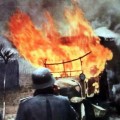Part 2
Germany, France and Russia already had elaborate war plans and proceeded to put them into effect - all failed. The object of the German "Schlieffen Plan" was to strike quickly against France, destroy her armies, and then turn against the more slowly mobilizing Russians, on the eastern flank. The plan almost succeeded. Massive German armies struck through Belgium, battered the fortified cities of Liege and Namur, and wheeled southward into France. At Mons a small British Expeditionary Force made a determined stand, but the task was impossible, and the "Old Contemptibles" were forced to retreat. Then, the German advance weakened, and the French and British counter-attacked. In the First Battle of the Marne the invasion was checked, and the Germans were driven back to a line along the Aisne River. The Schlieffen Plan had failed.
The French "Plan XVII" also failed as French drives against Germany in Alsace and Lorraine were bloodily repulsed. On the eastern front the outcome was similar. At first the Russians, moving with unexpected speed, threw back the Austro-Hungarians and advanced into Eastern Prussia. The Allied hopes were dashed as the Germans under von Hindenburg inflicted a crushing defeat on the Russian armies at Tannenberg and the Masurian Lakes. By late autumn a military deadlock had been reached on both the eastern and the western fronts.
In the west, after the "Miracle of the Marne", there followed a race to the sea as German and Allied armies tried to outflank each other in a desperate bid to gain the Channel ports. While the heavy fighting moved north, the battlefields to the south became quiet. The soldiers there dug themselves into the ground to provide shelter and security from bullets and shells. The Germans were able to select the best positions for a defensive position - already they were expecting to defend a line rather than to attack on the Western Front. The positions they selected were not only, generally, excellent from the point of view of defense, they also ensured that vital strategic railways to maintain their armies were secure and away from enemy artillery, well behind the lines.
They also took full advantage of the heavily industrialized areas of France and Belgium now under their control. These early and primitive fortifications were a start to a complex system of trench lines, machine gun and artillery positions that were to reach their height with the construction of the Hindenburg Line in the winter of 1916/1917. But at this stage they were simple trenches defended at best with a few strands of barbed wire. By December 1918 the line stretched for 750 kilometers from the Belgian coast to the Swiss frontier; and it was on this Western Front that Canada was to be chiefly engaged.
On October 29 the German army made one final effort to reach the Channel ports. In the First Battle of Ypres, in a little corner of Belgium known as Flanders, the British Expeditionary Force and their French allies held against overwhelming odds and the ports were saved. Unfortunately in these early campaigns Britain lost the greater part of her precious regular army; while the efforts to protect the Ypres Salient were to be even more costly in the future.

